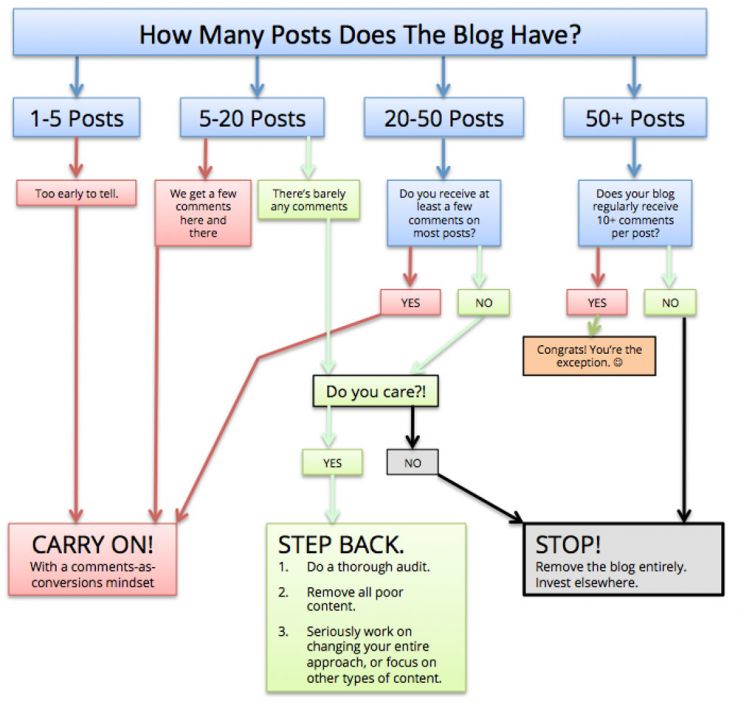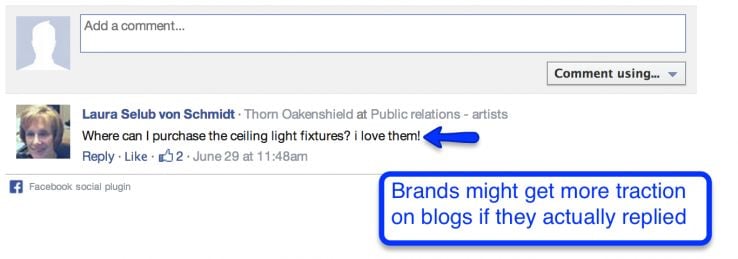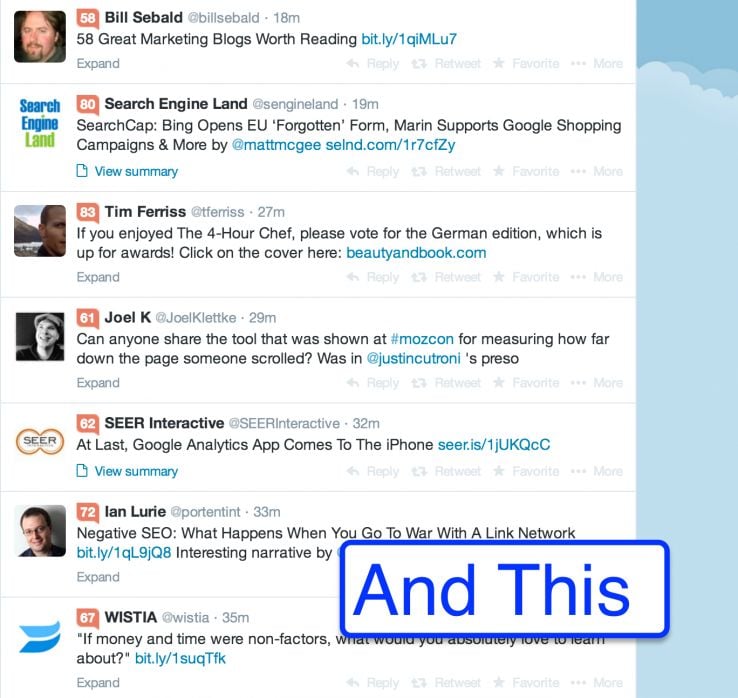
The Broken Art of Company Blogging (and the Ignored Metric that Could Save Us All)
The author's views are entirely their own (excluding the unlikely event of hypnosis) and may not always reflect the views of Moz.
The perception of success
The following screenshot is from an actual blog post. Based upon what you see here, would you call it successful?

I think it depends on perception.
The optimist might see this:
590 LinkedIn Shares
(This also might be what you put in reports to your boss) :)

The Twitter and Facebook manager might see this:
70 Tweets and 21 Likes

I see this:
Zero comments

Same blog post; three different measures of success. One looks great, one is OK, and my measure says its a fail.
But which perception is right? Which one would lead to better blogging decisions?
Let's look at it another way. Here's a the blog homepage of a known brand. Most people probably see it like this:

They scan:
- pictures
- titles
- maybe a category or two
You might judge these posts based on whether the topics sound interesting, or if they are using high-quality unique photos.
Here's how I see the same thing;

See the pattern?



Post after post receives no comments.
In fact, here's how many comments this well-known brand received across 50 posts;

TEN! That's an average of 0.2 comments per post. This is a well-known company, but I'm not here to call anyone out; it doesn't matter who it is, because this is the NORM.
Only 10 people felt this blog was worth a few minutes of their time. Only 10 thought the content was good enough to say "thanks." That's a huge problem that no one is talking about.
Blind to blogging failure
A company blog with no comments after years of posting is a fail . But we don't see it. It should look and feel a lot like this to us:
NO one would look at this frankencar and call it a success. Or say "yeah, you should make more just like that!" It borders on absurdity. But when we see company blogs with 50 posts and barely any comments, we don't notice anything wrong.
And therein lies the problem.
The following post with zero comments is not universally accepted as unsuccessful:

We look at vanity metrics like shares, tweets, and likes. None of those actually matter. Most people who just share don't even read the post. And my plan for the rest of this post is to explain why, and what we can do to fix it.
Oh, and hey, does this guy look familiar?

Five business blogging myths
How did this happen? How did we get in such a predicament?
Companies are confused. They have no idea why they even have a blog. Some think they know, but the reasons generally fall into one of these five myths:
Myth 1: Your site needs fresh content
OK, hang on right there. Google once announced something called the freshness update in 2011. This created undo mass hysteria (just like "duplicate content" did, but let's not even get into that).
Basically this idea of freshness spread and permeated into this belief that all websites always had to be cranking out content all. of. the. time. Yikes, was this bad for the internet IMO. Content can be posted as often as you can but without forsaking quality.
Myth 2: The MORE content the better
Thankfully, I think this myth is finally slowly dying. It only took four Pandas to finally wake a lot more people up to that.
Keep this rule in mind: Unused content is dangerous. It's dangerous for your site because Google is looking for this sort of thing with Panda (I believe). People should actually be visiting your content (hopefully over and over again); otherwise it doesn't belong on your site.
Myth 3: Blogs automatically help SEO
And the variation I hear to this is "blog posts are where you throw all of your keywords. Over and over. " WRONG! Blogging does not automatically help SEO. (Granted this myth may have been slightly more true pre-Panda, but still wasn't a good strategy).
The truth today? Blog posts have more of a chance of hurting your SEO than helping. Unless you are willing to put an honest effort in, I would stay away from that assumption.
Myth 4: A blog is just a news feed
Gah! Are you CNN or TechCrunch? There are thousands of perfectly good news sites, in all industries out there. Unless this is your core business model, I'd recommend staying away from a news format in your company blog. Stop reporting and start connecting.
Myth 5: Blogs are for generating leads
I'm going to defer to Tad Chef on this one. Blogs are for getting leads... eventually. But usually not on "first touch."
If you're blogging for any of the above reasons, I assure you, they're only going to get you in trouble.
"Comments per post" can save us
I believe there's a solution to this madness and feel that whether or not your blog is receiving comments should guide your entire blogging effort. Let's call this simple metric "comments per post."
total # of comments / total # of posts = comments per post
You can use this simple number to measure blogging success (or failure). For any company currently running a blog, follow this flow chart to see if you're on track:

Where does your company blog fit in?
I bet if most companies went by this chart, 95% of company blogs would get shut down. Which in my opinion, wouldn't be a bad thing at all.
You see, comments per post can tell you a lot:
- Should we continue blogging?
- Is our blog "working" and getting traction?
- Are we connecting with customers?
- Should we step back and reassess our purpose?
- Should we stop blogging and remove the blog entirely?
Ideally, you would track comments per post over time as the central success/failure measure of the company blog.
Why "comments per post," you ask? Well, I believe there are exponential benefits to using this as your central blogging metric. Let's take a look at some of the big ones.
Commenting users are engaged
As my two stick figure friends will show you, people who comment are highly engaged;

And conversely, those that do not comment are likely not as engaged;

On-page benefits

- They add social proof that other people actually read your content.
- When you reply back, it shows the public you listen and care.
- Discussions often add extra value to your content.
SEO Benefits
Comments also add more keyword desi....... kidding.
You didn't
really think I was going to go there, did you? ;-)
No, seriously, as Rand pointed out in a recent Whiteboard Friday, SEO takes input from all kinds of sources. Most everything will influence rankings in one way or another.
Here's how I believe a company blog positioned to earn comments reaps SEO benefits:

Let's walk through one example: repeat traffic. How does a comment create a higher likelihood of repeat visits?
Simple: notifications!

Here's how it works;
- Danny Sullivan writes a post on something I am highly interested in.
- It's the most in depth analysis I've seen, so I wanted to ask a question, and add some of my own insight, so I leave a comment.
- Disqus emails me when Danny writes back.
- Naturally, I want to go back, read the response, and maybe leave a further response.
(This should also give site owners yet another reason to reply to people. It's a pretty certain way to get them to come back. And BTW Pat Flynn has a great resource here specifically about his experience with Disqus.)
Early commenting predicts future success (or failure)
You don't have to wait until you're 6 months into blogging to figure out how well it's going. You can tell after just a handful of posts. That's what I believe anyway. Assuming a younger blog (of say 5-10 posts) is getting at least some traffic, if there's no discussion, there's no traction.
When real people react to your content in a genuine way, you know you are onto something. Using social share numbers as the litmus for "success" is a terrible idea.
Simple
Most of all, I like that this method is simple, and pretty accurate in my opinion. You don't need fancy software to tell you if your blog is working.
Why successful company blogs earn comments
I want to switch gears and show you real examples of some of the most successful and commented-on company blogs.
Setup and approach
1. Care about comments or don't blog
My first two examples are of companies that DON'T blog! For many companies this will be your best option.
Let's look at Guitar Center. They actually had a blog a one point;

But they killed the whole thing. I think this was a smart move.
Restoration Hardware doesn't have a blog either;

I wish more companies would start following this trend. I assume Restoration Hardware is honest with themselves, and knows you don't just go through the "blogging motions."
Lack of comments = lack of engagement = people probably don't care about the blog = kill it and move on.
2. Build relationships outside of the blog
Lots of people who comment on my company blog are colleagues or friends. Here is a personal example;

Blogs are just like any form of communication: email, social media, or text messages. Literally think of your next blog post as if it's an email to your best friend.
3. Brand your blog
Marriott's blog by Bill Marriott is by far one of the best business blogs I have found. Their clever branding of calling it "Marriott On The Move" sets it apart. It makes it memorable:

I also want to point out, this actually generates search volume for "Marriott On the Move."

This by the way is what I call " PropWords" (Proprietary Keywords). These are branded keywords that YOU create for a blog name, product, event and so forth that become extensions of your branding.
This is an important signal for SEO right now as I believe Google is definitely looking at these kinds of queries when trying to gauge trust and popularity of a site.
4. Hire people who can actually write
If there was an electrical problem in your office, would you just have any random person fix it? No, you'd probably call an electrician.
If your company needs quality writing on your site, that's going to represent your brand, do you just get anyone to do it? No, you'd probably find a real writer.
That's exactly what King Authur Flour did. And it's paid off big time.
They brought in an actual author (of, you know, books!), PJ Hamel:

PJ writes a large portion of their posts, and responds to comments as well. And believe me, for a company making flour, there's more comments than you'd expect.
Even early on in the blog's life in 2008, it received a lot comments. Something was going right from the start;

Contrary to this, let's look at DreamHost's blog. (And by the way I'm a DreamHost customer, so this is no slight to their product).
But how do they go about finding writers?

DreamHost apparently just wants little robots to crank out content on topics such as "web hosting" or "other." Really? What's "other?" We can just write about anything?
And, unfortunately, it shows in the results. Using comments per post as the measure of success, the blog is not very successful;
5. Use a voting system
Wegman's is running a seriously killer blog. I'll be using more examples from their site. But the first is the use of a simple voting system;

This adds to the level of engagement and social proof. I know what you're thinking, too - 34 shares? Big failure, right?

WRONG. Remember. Comments per post is our success metric. This one received 61 Comments. That's some pretty awesome discussion. I'd take that any day over tweets.
6. Make it easy to register
What is it like if you try to just leave a simple comment on the Southwest Airlines blog?

It's a major headache! Definitely reduce friction when it comes to users being able to quickly leave comments.
Content ideation and creation
1. Relate with values
Jason Fried comes to mind as one of the most successful bloggers of all time. What helped make him so successful? He's not afraid to talk about grilling on a web design and software blog;

But why does this work? It's right in the first sentence. "Simple products that solve real problems." That's a common value. And 37 Signals (now BaseCamp) has always been about attracting people with similar (and sometimes unconventional) beliefs.
This post received 36 comments back in 2006 when they were not as well known;

You might think "well, big deal;" they were pretty well known by then. And I want to point out - in 2003, they were regularly receiving lots of comments;
2. Continue a prior conversation
This is SO underutilized. People are already attentive and engaged around a particular discussion. You can easily continue that discussion in a new post. Just like what Bill Marriott has done brilliantly here;

There's a lot going on here;
- He's continuing a prior conversation (people are attentive and engaged)
- He shows he's actually listening to and reading people's comments, which encourages future commenting.
- He's adding more value by curating the tips readers left, and bring the best ones to the surface.
- He barely had to create any new content himself! Now that's efficient.
3. React to misguided Quora questions
Chances are if someone is asking debatable/controversial questions in Quora, this is going to generate some discussion. You can answer this on your blog and bring some discussion with you. And that's exactly what Rand did here:

I don't think he was thinking "oh, how can we get more comments on Moz." I think he probably saw it as an opportunity to settle some misconceptions about SEO. But in the process it generated some great discussion.
4. Involve others in the creation process
As I keep reiterating, blogging is a two-way communication platform. Wistia here shows us how they involved other companies in the creation and research process;

This undoubtedly had a positive impact on not only the reception, but also the discussion of this content. This post received 73 comments.
5. Add a personal touch
This is SO. Especially. Important. For company blogs! People are going to naturally view you as this big entity. You can counteract that with personal touches. It humanizes the experience and allows you to connect with your fans on a deeper level;
Here's another example from Wegman's

There's actually a lot going on here too;
- The signature is handwritten
- Her title is clearly labeled
- "Since 1971" - wow, this speaks of tradition, commitment, consistency.
- Incredible service - not just "customer service" (bland corporate-speak) but incredible.
The signature says a lot, actually.
Back to Bill Marriott's blog - you can also listen to all of his posts, which is a nice personal touch as well;

6. Bring the offline online with a story
"Tell a story" is starting to get a little overused. Just like "write quality content" it runs the risk of being empty advice. What does that mean "tell a story"? Here are some great examples:
 Eric Allen, a flight crew member at FedEx, tells us the touching story of his daughter who was diagnosed with a brain tumor.
Eric Allen, a flight crew member at FedEx, tells us the touching story of his daughter who was diagnosed with a brain tumor.
Customers just passing by can't help but stop to give their best wishes;

Another superb example of bringing an offline story to online is Verdant Tea;

I want to point something out. For many of these companies the blog is simply an extension of their evolving story.

You don't find a story because you have to blog. You have to blog so you can tell your story.
7. Provide a call to action
How many blog posts have you seen, end with "what do you think"?

It's like we get to the end of writing, realize there's a comment box below, and go "oh I guess I should ask something now!".
I really like how Bill Marriott does it here;

Bill's call to action is specific. A call to action will also rolls easily off an already-good article. We're also reminded of the branding and personal touch at the end. This helps reinforce that we can have a direct, personal conversation.
Maintaining your commenting community
1. Kill off spam like crazy
Comment spam can ruin your blogging efforts in a lot of ways. It looks bad to search engines, and it looks bad to users. Kind of like the broken windows theory for blogs. It casts the impression that no one cares;

No one wants to hang around a place like that for too long. I'm militant about deleting spam on my own site (I check at least once a day).
2. Heavily moderate and make it well known you moderate
Although not a company blog per se, I just think Tim Ferriss sets an exceptional example of moderation;
 His readers know that nothing uncool is accepted. This makes everyone WAY more comfortable to comment. They know things won't get out of hand.
His readers know that nothing uncool is accepted. This makes everyone WAY more comfortable to comment. They know things won't get out of hand.
Here's an example of a comment on my blog, in reply to someone else. It's not very friendly, so it goes in the trash!

Go forth and delete ;)
3. Listen and respond!
My goodness, what a lost opportunity for so many brands. Responding has several benefits;
- It "doubles" the comment count.
- It shows customers you care and listen.
- It makes them MORE likely to comment again in the future.
- As mentioned before, many comment systems like Disqus will send email notifications, which brings traffic back to your site.
It kills me to see this;

If someone walked up to you in a retail store, and asked you a question, would you just ignore them an walk away? Why are questions in comments any different?
Harvest, however, is very attentive to their customers' questions;

Jonathan does a great job answering a slightly annoyed question.
Here's King Authur Flour again. Someone asked a question and TWO people from the company answered;

4. Continuously prune

The thing about blogs, is they can become overgrown quickly. Noindex or delete posts that have received little traffic, few shares, and no comments.
If you have a big blog, which has been running for a while, you should conduct any number of content audits and prune fairly aggressively!
5. Outreach: Stop asking for shares; ask for comments instead
This has been done TO me (and I wish I could find the example). It worked really well though, and I would suggest it in your outreach process.
Think about it: If you ask someone to comment or leave feedback they HAVE to at least read the content, process it, and think about it. They're more likely to remember you, and potentially share the article anyway. And you might start to build a deeper relationship.
I consider an "influencer's" comment on my posts to be a lasting gift. It's there etched in stone for anyone to see. Social shares fade fast.
To earn a comment is to earn attention
And attention is the web's most valuable currency.
Especially when Bill Sebald is involved :-)

This is crazy (but all too common);

This is what we're all competing with!
The attention web revolution
We're seeing a dramatic shift happen right now. There's way more content, but never more time. Attention is getting harder to earn.
I think my anecdotal chart may explain it best;

Pre 2013 - it was easier to create shareworthy content and call this a "success." But we're entering an era where attention-worthy wins. The early adopters (UpWorthy, Chartbeat, etc.) are getting a head start.
I'm definitely not the first to talk about the importance of an attention-centered content approach:
- November 2013 - Medium tells us the only metric that matters is total reading time.
- January 2014 - AJ Kohn's brilliant piece asks: Are You Winning The Attention Auction?.
- February 2014 - Upworthy reveals their attention minutes to the world.
- March 2014 - Tony Haile's well known piece for Time showed us people aren't even reading what they're sharing. (I should note that as the CEO of Chartbeat, Tony does have a personal investment in this concept).
Executive attention
There's two ways to get your attention.
- That car fire might get your attention. But this would get an involuntary, reactive form of attention. Not what we want from our readings. This is the kind of attention sites like BuzzFeed get.
- Rather, we want the kind of attention where you choose to focus on something (and ignore other things). An intentional attention. Look at wikipedia's definition of Executive (Endogenous) Attention;
"... top-down processing, also known as goal-driven, endogenous attention, attentional control or executive attention. This aspect of our attentional orienting is under the control of the person who is attending."
THAT'S the type of attention you want. Someone intentionally reading, processing and interacting with your content.
A user commenting on a post is usually someone giving you just that.
Full circle
Remember at the beginning? We looked at this chart of a major brand's comments;

Remember, that's only 10 comments across 50 posts.
This is Wegman's stats for the same thing;

Wegman's has 1,857 comments across 50 posts. In fact, the first site is still in the chart. It's just so small, you can't even see it.
On ONE post alone they got 1,092 comments;

A new standard of success
So let's take a look at this again. What do you see now?

These aren't just numbers. This tells a story.
It tells the story of a company that blogs because it thinks it has to.
It celebrates "success" as tweets and likes and votes.
Customers do not connect with this brand.
It doesn't listen to its customers.
There is no dialogue.
No connection.
So, you probably know what to do below, and I will actually respond :)

-Dan Shure
Moz Associate since 2012
Owner Evolving SEO since 2010
PS: Speaking of discussion, I happen to be doing an Ask Me Anything over on Reddit today at 1pm EDT. If you want to ask me anything at all (whether or not it's related to this post), head on over.










Comments
Please keep your comments TAGFEE by following the community etiquette
Comments are closed. Got a burning question? Head to our Q&A section to start a new conversation.